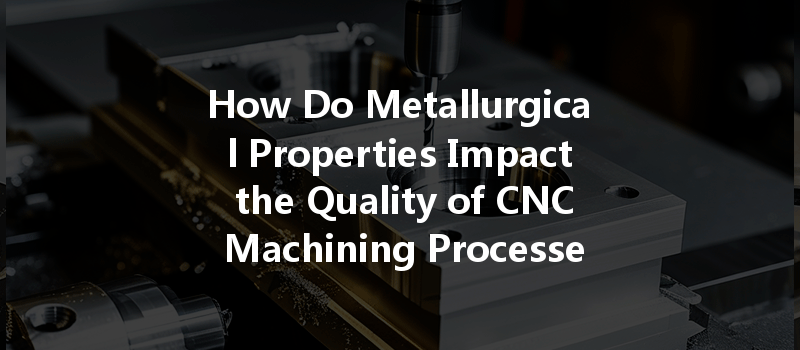Did you know that nearly 70% of product failures in aerospace components can be traced back to inadequate material properties? This startling statistic emphasizes the critical importance of metallurgical properties in manufacturing processes, particularly in CNC machining. As industries continually strive for higher efficiency and product quality, understanding how these properties influence machining outcomes becomes essential for engineers and manufacturers alike.
The Importance of Metallurgical Properties in CNC Machining
CNC (Computer Numerical Control) machining is a complex, highly accurate manufacturing process that relies on precise control of machine tools. This precision can be compromised if the materials being used do not have the appropriate metallurgical properties. Factors like tensile strength, hardness, ductility, and thermal conductivity directly affect how materials behave under various machining conditions. For businesses looking to optimize their CNC machining processes, understanding these properties is critical.
Key Metallurgical Properties That Affect CNC Machining
Tensile strength is the maximum amount of tensile (pulling) stress a material can withstand before failure. Materials with high tensile strength often have a more robust performance during the machining process as they resist deformation, leading to more accurate cuts and a smoother finish.
Hardness defines a material’s resistance to deformation. Harder materials can be more challenging to machine but provide better wear resistance. Selecting the right tools and machining parameters becomes crucial when dealing with hard materials to avoid tool wear and failure.
Ductility describes a material’s ability to deform under tensile stress. While ductile materials are easier to machine and shape, excessively ductile materials may lead to issues such as poor surface finish and excessive tool wear. Understanding a material’s ductility ensures that CNC operators can make informed decisions about feed rates and tool selection.
Thermal conductivity influences how heat flows through a material during machining. High thermal conductivity often prevents overheating, which can reduce tool wear and improve component quality. Conversely, materials with poor thermal conductivity can lead to hot spots that cause rapid tool degradation and affect tolerances.
Addressing Challenges: Solutions for Optimizing CNC Machining
Understanding the impact of these metallurgical properties enables manufacturers to optimize their CNC machining processes effectively. Here are several strategies to consider:
Choose the appropriate material based on the specific requirements of the project. For example, if the application involves high temperatures, selecting materials with good thermal properties is vital.
Invest in high-quality cutting tools made from durable materials suited for the specific metallurgical properties of the workpiece. Tools made from carbide or ceramic can be excellent choices for harder materials.

Set optimal speed, feed rates, and depth of cut tailored to the material being machined. Diligently assessing each of these parameters can enhance both efficiency and quality.
Proper cooling methods, such as flood coolant, mist coolant, or dry machining, can significantly influence thermal management. Effective cooling reduces heat generation, which prolongs tool life and maintains surface quality.
Implement a thorough maintenance plan for CNC machines. Regularly inspecting and recalibrating machines will ensure consistent performance and reduce the risk of defects due to improper machine behavior.
The Role of Advanced Technologies in CNC Machining
As technology advances, incorporating sophisticated machinery and software in CNC machining operations can help mitigate the negative effects of material properties. Intelligent CNC systems equipped with real-time monitoring capabilities can dynamically adjust cutting parameters based on feedback from the machining process. Additionally, utilizing simulation software can help predict how a material will behave under specific conditions, allowing for better pre-production planning.
Moreover, additive manufacturing can complement CNC machining. By understanding and combining these technologies, manufacturers can synthesize stronger materials or tailor alloys specifically to meet the demands of various applications, thereby improving overall machining quality.
Case Studies: Success Stories in Optimizing CNC Machining via Metallurgical Insights
In the aerospace industry, a leading manufacturer facing increased product failures attributed to inadequate material selection turned to detailed metallurgical analysis. By employing advanced materials with high tensile strength and hardness, the company improved product reliability by nearly 50%.
An automotive parts producer was able to significantly cut down material waste by re-evaluating their tooling strategies, particularly when working with high-strength steel. By utilizing appropriate coatings and tools engineered for hard materials, they achieved a 30% increase in efficiency while maintaining component quality.
A medical device manufacturer invested in research to understand the effects of different alloys on machinability and device longevity. By selecting a metal with enhanced ductility suited for intricate machining, they ensured better surface finishes and overall product performance, which ultimately led to increased patient safety.
The world of CNC machining is significantly influenced by the metallurgical properties of materials. By understanding attributes such as tensile strength, hardness, ductility, and thermal conductivity, manufacturers can streamline their production processes and enhance product quality. Implementing proper tooling, optimizing machining parameters, and adopting new technologies can further address the challenges posed by different materials.
As industries rapidly evolve and product demands heighten, the relevance of metallurgical properties in CNC machining will only continue to grow. Manufacturers can no longer afford to overlook the importance of material selection and their properties. By considering these factors, businesses can not only improve efficiency and reduce costs but also deliver high-quality products that meet the expectations of today’s discerning markets.






